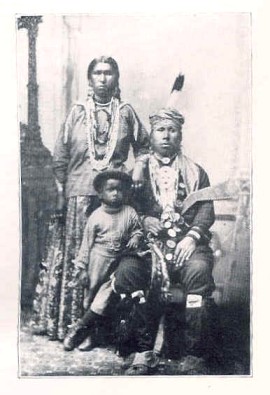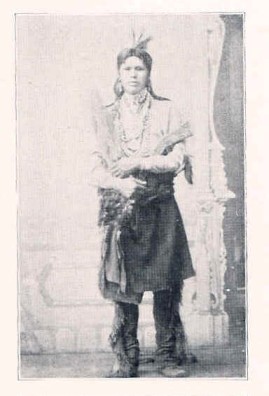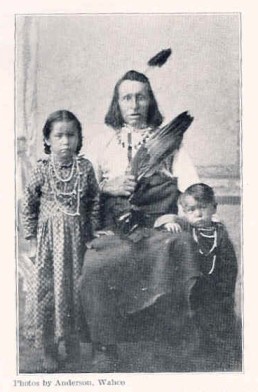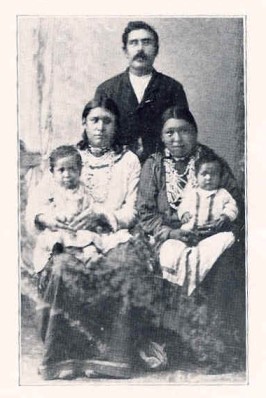|
25
CHAPTER II
ABORIGINAL INHABITANTS
The first inhabitants of the State of Nebraska of whom we have any record are the people of the Stone Age. Many of their implements and articles of pottery have been found in the state, principally along the waterways, thus proving that in their excursions into this part of the country they did not venture very far from the streams. Here they found game and fish and wild vegetables, which edibles comprised their daily fare; these ancient peoples did not cultivate the soil. In the southeastern part of the state the most primitive of these archeological implements have been found; a few chipped implements have been discovered along the banks of the Platte River; chipped flints, potsherds, beaten ornaments and lodge circles have been found in great abundance along the Platte and its tributaries.
The Watkins History of Nebraska says: "One of the three propositions is true, either wholly or in part: first, the aborigine was extinct before civilization came to this continent; second, the Amerind (American Indian), with implements obtained from the whites, drove out the aborigine: or third, he was, himself. supplied with implements of civilization and is now counted an Amerind. Archeology has to deal with prehistoric man, the man who used the implements of the Stone Age, and when this aborigine has developed into an Amerind, ethnology takes up the study where archeology leaves off. If the aborigine frequented a spot there was certainly a reason for so doing. Let us examine the conditions that would entice the primitive Stone Age man. The white man cultivates the soil and produces his subsistence. but the aborigine followed the chase and supplied his wants direct from nature; to do this he must have flint or some kind of stone from which to make his implements. Flint is the most available
26 PAST AND PRESENT OF SAUNDERS COUNTY
material for this purpose, as it possesses the property of conchoidal fracture, as well as great toughness, very desirable in stone-cutting implements."
Thus, in the localities where the most desirable type of stone was to be found the Stone Age man made his principal settlement. He used a very primitive, but systematic method, of quarrying for these implements and in several places in the state may be found the remains of these large quarries. Many of them have not yet been fully explored.
The presence of the American bison upon the Nebraska prairies to a great extent led the Indian to make his home here. When the first white settlers came to this territory they discovered that the red men were taking little or no interest in agriculture; they were subsisting well upon the buffalo and the other species of game to be found here. In the pursuit of this game they were migrating gradually from the eastward to the westward. They belonged to the two linguistic families - the Siouan and Algonkian. It is said that they came from the land to the east of the Appalachian mountains, spreading over the whole Middle West after leaving their native hunting grounds.
However, these two linguistic branches were not the only ones who occupied the territory now included in the State of Nebraska. The Caddoan linguistic family from the south in the vicinity of Red River and the Shoshonean and Kiowan from the west also came here. The Caddoan peoples came up by way of the Kansas River Valley, and penetrated as far northward as the Platte River Valley and to the westward as far as the mountains. The latter two camped near the source of the Republican and Platte rivers. Although these five different families once dwelt within the boundaries of the state, the best historical authorities will state that only the Caddoan and Siouan played an important part in the early history of the state; in fact, they are the only ones of the five who have left the knowledge that they built permanent homes here.
As mentioned before the original home of the Caddoan linguistic families was the region of the Red River, in the south. One band, known as the Skidi, left the main stock and emigrated to the Platte River Valley. This was before the year 1400. Before 1500 another band left the main body and came northward
PAST AND PRESENT OF SAUNDERS COUNTY 27
to a point near the present boundary line between Kansas and Nebraska. At this juncture the Wichitas returned southward and the Pawnees moved farther north and located in the Platte Valley. In 1541 the explorer, Coronado, discovered the tribe of Wichitas near the Kansas River and commanded one of then-chiefs ("Lord of Harahey") to visit him. The chief came, accompanied by 200 warriors. Most recent state history claims that this is the first authentic record of Indian occupancy of Nebraska, also the first time civilized man ever saw an Indian from the territory now the State of Nebraska.
The Pawnee tribe consisted of three main tribes -- the Choui (or Grand), the Pita-how-e-rat (or Tapage), and the Kit-ke-hak-i, or Republican; these three branches came to the vicinity of Nebraska sometime before the year 1500. The Pawnees were victorious in the subsequent struggle with the Skidi who had come 100 years previous, and succeeded in holding territory about fifty miles west of the Missouri River. The Skidi were merged with the Pawnee tribe after their defeat.
PAWNEE HOMES AND LIFE
The following quotation from the Huntsman's Echo of February '21, 1861, re-quoted from the Watkins History of Nebraska, gives an intimate and instructive description of the Pawnee home and some peculiarities of their life. Such homes as these existed in Saunders County, one especially at Wahoo.
"The Pawnees number at present about four thousand souls and a fraction over, and when 'at home' live in a cluster of huts built with crotches and poles, covered, top and sides, with willows, then with grass and dirt, giving the appearance at a little distance of an immense collection of 'potatoe hills,' all of a circular shape and oval. The entrance is through a passage walled with earth, the hole in the center at top serving both for window and chimney, the fire being built in the center. Along the sides little apartments are divided off from the main room by partitions of willow, rush or flag, some of them being neatly and tidily constructed, and altogether these lodges are quite roomy and comfortable, and each is frequently the abode of two or more families. In these villages there is no regularity of streets, walks, or alleys, but each
28 PAST AND PRESENT OF SAUNDRRS COUNTY
builds in rather a promiscuous manner, having no other care than to taste and convenience. The tribe is divided into five bands, each being under a special chief or leader, and the whole confederation being under one principal chief. Each band has its habitation separate and distinct from the other, three bands living in villages adjoining and all composing one village, the other two villages at some little distance. There is frequently considerable rivalry between the several bands in fighting, hunting, and other sports, and not infrequently one band commits thefts upon the effects of another."
Again quoting from the History of Nebraska, 1907: "At this time, we are told, the Pawnees had several thousand horses, but owing to the hard winter hundreds had died from sore-tongue and other diseases. The animals lived out all the winter upon the dry grass; but if the snow was too deep for them to reach it, cottonwood trees were cut down and the horses would subsist upon the bark. These horses were above the luxuries of civilized life, and refused to eat corn when it was placed before them. They were valued at from $30 to $60 each.
"The Pawnees at this time usually took two general hunts each year in which all the people, old, young, great, and small participated, abandoning their villages to go to the buffalo range. From the spoils of the summer hunt they made jerked meat and lodge skins; and from those of the fall hunt, in October and November, they made robes, furs, tanned skins, and dried meat. These Indians had a field of considerable extent near each village where the land was allotted to the various families, and goodly quantities of corn and beans were grown. With these and a little flour and sugar they managed to eke out a miserable existence, sometimes full-fed and sometimes starved.
"'The females are the working bees of the hive; they dig up the soil, raise and gather the crops, cut timber and build the lodges, pack wood and water, cook, nurse the babies, carry all the burdens, tan the skins and make the robes and moccasins. Their lords and masters recline by the fire or in the shade, kill the game and their enemies, do the stealing and most of the eating, wear the most ornaments, and play the dandy in their way to a scratch. They are of a tall, graceful, and athletic figure, as straight as an arrow and as proud as a lord, whilst the squaws are
PAST AND PRESENT OF SAUNDERS COUNTY 29
short, thick, stooping, poorly clad, filthy, and squalid. Parentless children and the very aged are sometimes left behind, or by the wayside, to perish as useless.',
Pike visited the Republican Pawnees in 1806; they dwelt near the south line of the state until about 1812, when they joined the rest of the band north of the Platte River. Dunbar gives the location of the various tribes in 1834: the Choui band resided on the south bank of the Platte, twenty miles above the mouth of the Loup; the Kit-ke-hak-i lived eighteen miles northwest, on the north side of the Loup; the Pita-how-e-rat, eleven miles farther up the Loup, and the Skidi, five miles above these; and he says they changed their villages every eight or ten years. In 1833 the Pawnees ceded the territory south of the Platte to the United States. In 1857 they ceded the territory north of the Platte, except their reservation in Nance County. The territory ceded, according to Charles C. Royce, embraced the central third of the entire state. The reservation above mentioned was ceded in 1876, and the Pawnees were taken to Indian Territory, where they now have a reservation."
OTOES
The Otoe Indians (a tribe of the Pawnees-Panismahas) are frequently mentioned in the history of Nebraska. They were, in all probability the Octotatas of Charlevoix, who placed them, in 1721, above the Kansas Indians, upon the Missouri. Lewis and Clark mentioned that their home was originally on the Missouri not far above the Platte mouth. Then they migrated up the Platte and were found there by the exploring expedition in 1804. From this position, about thirty miles above the mouth of the Platte, they came back to the Missouri River and established villages where the City of Omaha is now located, but they soon returned to their former homes on the banks of the Platte. After this they again left this latter location and resought the Missouri, a few miles south of the present site of Nebraska City. On March 15, 1854, the confederate tribes of Otoes and Missouris ceded to the United States all their country west of the Missouri River except a strip of land on the waters of Big Blue River, ten miles in width. Successive treaties were made by this tribe
30 PAST AND PRESENT OF SAUNDERS COUNTY
with the Government, until now there are none left in the state. The same is true with the other Indian tribes which were once confined upon reservations set apart for them by the Government.
THE INDIAN TOWNS OF SAUNDERS COUNTY
Perhaps the 'most prominent of the various sites of former Indian towns in Saunders County is that of Leshara. This village was brought into existence by the building of the Great Northern-Burlington line from Sioux City to Ashland in 1905.
As written in every account of early Indian settlement in the state the Pawnees were the predominant race, or tribe, of this section of the state particularly. They were a brave, fighting people, always at war with the Sioux and were finally the losers. The Pawnee towns were no small affairs, such as rows of teepees, but their houses were constructed of timber, with prairie sod facing the roof. Near the present site of Leshara, in fact covering a portion of the present residence blocks, was located one of the principal towns. In later years the white men knew it to have a population of several hundred. The town was in existence at the time of the Lewis and dark expedition and is mentioned in their reports as having been visited by one of their scouting parties. This makes a known history of the place of over a century. Many Indian relics have been found on the town site and are still encountered in the grading of roads and plowing of fields. Most prominent among the Indians of this village was Pita, or Peter, Leshara, a splendid type of the Pawnee tribe, over six feet in height and of commanding appearance. Pita Leshara is still remembered by some of the old settlers of this vicinity. A monument to the Pawnees has been erected at Leshara on the McLain farm.
Other Indian sites in the county are: the Bryant site near Yutan, the Estey site seven miles south of Fremont, the McLain site immediately across the river from Fremont, the Gibson site near Swedeburg, and the Ithaca site. A. E. Sheldon wrote the following of the Ithaca site: "Such a place was of course not overlooked by the Indians. A village was located here on the bench below the hill as proved by excavations. On the top of the mound are Indian graves. Several of these have been opened
|









